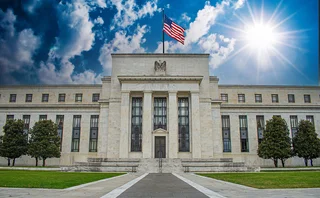
Dependence on collateral raises vital research questions
Areas of focus should include collateral supply, reuse and circulation

Manmohan Singh is a senior economist with the International Monetary Fund in Washington, DC.
Regulatory reform in the wake of the financial crisis has put collateral at the top of the agenda for banks, regulators and the academic community alike. As well as recent work done at the Bank of England, Reserve Bank of Australia, Bundesbank, MIT and University of Illinois, several dissertations and public sector projects in the past couple of years are now building the microeconomic foundations to explore concepts such as rehypothecation, collateral reuse and the interface between monetary policy and market plumbing.
Collateral does not flow in a vacuum; it needs balance sheets to move within the financial system. Collateral flows lie at the heart of any proper understanding of market liquidity, and are as important a driver of credit creation as money itself. The pledged-collateral world spans many jurisdictions and cannot be documented through the lens of one jurisdiction or national accounts such as flow of funds. The goal of current research is to fill this void by providing several examples of how to augment the myopic thinking that stems from a focus on national data sources. Furthermore, most of the topics embrace the literature on shadow banking, which tends to be viewed somewhat negatively.
Collateral flows lie at the heart of any proper understanding of market liquidity, and are as important a driver of credit creation as money itself
Central banks' quantitative easing (QE) efforts have added another dimension to collateral research, since global financial lubrication comes from both money and financial collateral. Since Lehman Brothers went bankrupt, regulators have acknowledged several weaknesses in the financial system. Unsurprisingly, the proposed regulatory agenda goes beyond the banks and now covers over-the-counter derivatives, the non-bank institutions that are interconnected with large banks, markets (including repo and securities lending), money market mutual funds, and many others. These activities represent the nuts and bolts of financial plumbing, which is lubricated by collateral and money.
Below are some of the key areas for current and future research.
Financial collateral
Cross-border financial markets traditionally use cash or cash equivalents (money or highly liquid fungible securities) to settle accounts. Financial collateral does not have to be high-quality AAA/AA rated securities. As long as the securities, which can be either debt or equity, are liquid, marked to market and part of a legal cross-border master agreement, they can be used as cash equivalents, and research shows that financial collateral volumes are on par with money metrics.
In the context of its operational use, collateral intermediation is likely to become more important over time. Although there is sizeable issuance of good collateral, very little reaches the market. It is increasingly important that policy-makers understand a new metric – that of collateral velocity, or the extent of the collateral used or reused in the financial system – especially when there is a shortage of good collateral or safe assets and monetary policy is stuck at the zero lower bound. It also provides some intuition behind frameworks such as the Fed's reverse repo programme.
Monetary policy and collateral interface
The relative prices of money and collateral matter. Some central banks are now major players in the collateral markets – and the larger the QE efforts, the longer the central banks will have an impact on the collateral markets and associated repo rates. A few central banks are continuing their QE programmes, and all the printed money that has replaced collateral will need to be addressed in due course. Large balance sheets are likely to be unwound, which will be challenging on many fronts. The Fed's "liftoff" in December 2015 underlined the fact that it is crucial to understand market signals such as repo rates since they have traditionally guided the policy rate. If central banks increase their footprint in the area of financial plumbing and absorb money directly onto their balance sheet, the plumbing becomes rusty. The associated market signals will be weaker and monetary policy transmission may be compromised if all short-term rates do not move in sync. This may also have implications for monetary policy and financial stability, since the repo rates map the financial landscape that straddles the bank/non-bank nexus.
Safe assets
Research on safe assets, especially from academia, supports the supply of good collateral from the lens of a public good. But this strand of research ignores the reuse of collateral in the market. After the crisis, we have seen a reduced pool of assets that are considered acceptable as collateral, resulting in a liquidity shortage. When trying to unwind QE, policy-makers will need to consider the supply and market price of collateral in addition to the traditional money metrics. The effective supply of good collateral to the market can also be increased by higher collateral reuse, and not only by the supply of T-bills and similar assets.
After the crisis, we have seen a reduced pool of assets that are considered acceptable as collateral, resulting in a liquidity shortage
Shadow banking
The bank/non-bank nexus is largely seen as a form of regulatory arbitrage. However, this is an incomplete view, since there is genuine economic demand for such services – and a key area of research lies in explaining the economics that support the demand and supply for the bank/non-bank market, the systemic risks that can arise within it and its regulatory and broader policy implications.
Under-collateralisation in OTC derivatives markets
There would be no need for central counterparties (CCPs) if everyone posted their share of collateral when using OTC derivatives. However, the proposed regulations concerned with moving most of this market to CCPs skirt the fundamental risk that resides in a bank – namely its derivatives liabilities. This is the cost to taxpayers resulting from a large bank's failure due to its derivatives positions. As regulations do not force every contract to go to CCPs, a suggested alternative is to place a levy on the user or its bank (which may not wish to let go of the business) with the primary objective that the bank's derivatives liabilities be minimised. Recent research by the US Treasury's Office of Financial Research also provides a critical look at the costs and benefits of moving to CCPs.
Breakdown in the financial plumbing
Non-banks such as CCPs are perhaps the most useful lens through which to see how regulators view the role of financial plumbing. If CCPs have, by regulatory fiat, become "too important to fail", the imperative should be for greater loss-sharing by participants that better aligns the distribution of risks and rewards of CCPs, the clearing members and derivatives end-users. In this context, any shortfalls in the so-called bail-in waterfalls at CCPs can be recouped after a crisis by resorting to a "gains haircut" whereby all users who profit from the crisis will need to trim their gains – in lieu of those who are out-of-the-money and bankrupt – so that the CCP survives.
The sovereign/bank nexus
The rhetoric about cutting the umbilical cord between banks and sovereigns will not achieve full traction unless sovereigns or quasi-sovereigns post collateral on their derivatives contracts with banks. But the large volume of business and associated revenue means most global banks active in the collateral space do not actually force such privileged clients to post collateral when the sovereigns are out-of-the-money on their derivatives contracts. The new regulations continue to exempt such clients from posting collateral and this nexus will therefore remain.
Global custodians
Custodians such as Euroclear, Clearstream, Bank of New York and others will impact the changing collateral space as the new regulations kick in. It is often assumed that if the large banks do not have the balance sheet space to move collateral, the global custodians will be the obvious conduits to pick up any slack. But indemnification requirements to their clients entail upfront capital provision, which is not cost effective. Before the collapse of Lehman Brothers, large dealer banks would oblige custodians by pushing out general collateral – such as IBM or Merck equities – along with "specials" that the dealers really wanted. There were fewer constraints on balance sheets back then. But custodians are mobilising collateral – for example by linking central securities depositories, as in the eurozone – and, going forward, their footprint in the collateral space will be important.
Changing collateral space
Collateral flow continues to be fine-tuned by regulatory demands stemming from Basel III, Dodd-Frank, the European Market Infrastructure Regulation and similar new rules, as well as central bank asset purchases. On the other hand, new debt issuance and collateral connectivity via global custodians alleviates some of the demand pressures. In a world of bank balance sheet constraints, moving collateral directly from a non-bank to another non-bank is difficult, but there have been some recent developments in this area. Long-term asset managers such as life insurers, pension funds and sovereign wealth funds desire collateral that is of low volatility but is not necessarily highly liquid. These entities will be net providers of liquidity. On the other hand, hedge funds and money market funds – and dealer banks under the new regulations – have a dramatically shifting need for collateral and they require it to be liquid.
Therefore a market solution could work where the "principal" model that embodies the banking industry shifts to an "agency" model. If this were to happen, the market would be a very different one, in which credit, duration and intermediation would have to be assumed by a new set of players – amid a changing set of rules.
The topics covered in this article are discussed in more detail in Collateral and financial plumbing, published by Risk Books, and in the latest issue of the Journal of Financial Market Infrastructures. The views expressed are those of the author and not necessarily those of the IMF.
Only users who have a paid subscription or are part of a corporate subscription are able to print or copy content.
To access these options, along with all other subscription benefits, please contact info@risk.net or view our subscription options here: http://subscriptions.risk.net/subscribe
You are currently unable to print this content. Please contact info@risk.net to find out more.
You are currently unable to copy this content. Please contact info@risk.net to find out more.
Copyright Infopro Digital Limited. All rights reserved.
As outlined in our terms and conditions, https://www.infopro-digital.com/terms-and-conditions/subscriptions/ (point 2.4), printing is limited to a single copy.
If you would like to purchase additional rights please email info@risk.net
Copyright Infopro Digital Limited. All rights reserved.
You may share this content using our article tools. As outlined in our terms and conditions, https://www.infopro-digital.com/terms-and-conditions/subscriptions/ (clause 2.4), an Authorised User may only make one copy of the materials for their own personal use. You must also comply with the restrictions in clause 2.5.
If you would like to purchase additional rights please email info@risk.net
More on Risk management
Squashing CVA still dominates XVA desks’ priorities
Dealers favour options-based strategies to manage charges; some explore contingent CDSs amid rising exposures
EU single portal faces battle to unify cyber incident reporting
Digital omnibus package accused of lacking ambition to truly streamline notification requirements
XVA desks prioritise core tech upgrades over AI
Vendor upgrades, cloud-native rebuilds and sensitivities tooling dominate 2026 budget road maps
Chicago data centre outage forced clearers to turn away clients
Friday’s cooling system failure highlights cracks in tech and concentration risk of big CCPs
LCH goes live with agency model for client clearing
English law version of FCM-style European trust model approved, as Eurex lags behind
US banks hoping for end of DFAST global market shock
As Fed consults on stress-test reform, lobby group argues regulator is double-counting market risk
NMRF framework: does it satisfy the ‘use test’?
Non-modellable risk factors affect risk sensitivity and face practical and calibration difficulties, argue two risk experts
Risk Awards 2026: The winners
Citi claims top derivatives prize, lifetime award for Dennis McLaughlin, JP Morgan wins equities







